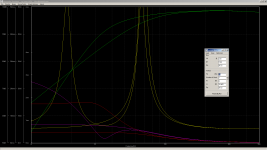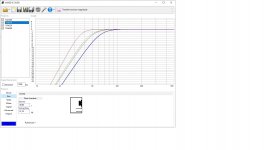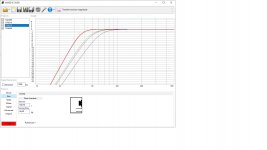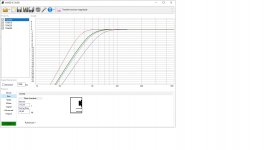Yes but from 2.5m it is ok with room gain. I think I use it at half of maximum use. What is good is that it goes low quite easily
This is interesting too :
https://www.eton-gmbh.com/en/products/home-hifi/orchestra/product/12-612c862-rp/
https://www.eton-gmbh.com/en/products/home-hifi/orchestra/product/12-612c862-rp/
It makes sense to fill the available gap with windings, but why not tighten the gap and increase saturation? Maybe a power handling issue?I asked myself it's not about the T/S parameters : more voice coil layers : less fine details (less short motion control from the amplifier) , taller voice coil , same ?
More overhang -- more inductance modulation issues, but also more Xmax.
A small VC seems good for sensitivity and fidelity, but the Xmax is a real catch-22 for power handling. A little more over-hang and you easily lose 3-6dB and before you know it, you have to increase the diameter so as not to start a fire. This is where I'm unsure if I'm reading the specs correctly. 500W seems frankly ridiculous for my home needs: <1W, background music, AV. But even I want to be sure that a pair of 12" can do +/-2-3mm for the occasional rumbles.
I was looking at the Eminence Beta 12A-2 and the Deltalite ii 2512, delivering about 98dB midbass in sims, rolling off to 80dB @ 30Hz in 60L sealed. It's already pushing 1mm (not sure if pk or rms) @ 2.83V. I have no idea how they compare in the HD olympics, so I'm kind of resorting to deduction.
It's the opposed forces that always get me thinking. A 50g cone vs 2kg motor (and surface areas) sets the amplitude ratio, and then it's standard practice to bulk up the box to try and stop the 2kg from moving. Not gonna happen.18's in general. Not that they can't work high, it just becomes much more difficult to keep box issues from effecting the sound. Open baffle would probably work well.
At this point I'm almost considering balsa wood. As long as the structure has solid bracing that links to the magnet, having the box vibrate like a dipole at low amplitude seems way more fun just based on gross tonnage.
Opposing woofers only way to go. Use two 15" instead of one 18" and that problem is solved. Remaining issue then is that pressure vessels with flat walls are hardly optimal.
Where is most of the motion force? Below 200 hz ?what about something like a kef 107 ref or kef 104 ref, vertical bass drivers arrengement. That means a bass that stays near 4Pi radiation, low xo for the mid that fire directly, transition circa 200 hz ? Vertical force cancelation helped by the enclosure weight.
Only trade off is front baffle width...large. But a Scala image well or you can make a front baffle a la kef 104/2...sorta of exernal front baffle for the mid and treble...trade off again you need a low Vas medium driver, more a 8" than a 10". But the bass cabinet will transmitt less towards the miid treble cabinet.
So we need huge Kef 104 ref pro loudspeaker...2 x 15" that fire up and down, 1×8", a wg 1.3" treble. 45 c. Width, 100cm heigth, very deep because the Vas of the 15" x 2... but when the front bafle is far of the front wall the soundstage is better....only remains the WAF. But Side woofers cancelation is complicated because of the near side wall indeed and also the next side loudspeaker in normal rooms. Loudspeaker like Blade from Kef is asking huge room imho...side walls far from the loudspeakers...and greater distance between the loudspeakers.
Only trade off is front baffle width...large. But a Scala image well or you can make a front baffle a la kef 104/2...sorta of exernal front baffle for the mid and treble...trade off again you need a low Vas medium driver, more a 8" than a 10". But the bass cabinet will transmitt less towards the miid treble cabinet.
So we need huge Kef 104 ref pro loudspeaker...2 x 15" that fire up and down, 1×8", a wg 1.3" treble. 45 c. Width, 100cm heigth, very deep because the Vas of the 15" x 2... but when the front bafle is far of the front wall the soundstage is better....only remains the WAF. But Side woofers cancelation is complicated because of the near side wall indeed and also the next side loudspeaker in normal rooms. Loudspeaker like Blade from Kef is asking huge room imho...side walls far from the loudspeakers...and greater distance between the loudspeakers.
Last edited:
Hello folks,
Could someone kindly make a simulation for 15pr400 and 15fh520 in vented cab, 100-120 l?
Not at home this week...
I think I might end with some of these
Could someone kindly make a simulation for 15pr400 and 15fh520 in vented cab, 100-120 l?
Not at home this week...
I think I might end with some of these
Quick-and-dirty vented and sealed sim for 15PR400, done on Subwoofer Simulator.
80L box for sealed, 120L for vented. I'm not sure what the units are for the vent dimensions, so you'll just have to double check.
I gave up with the 15FH510, but it looks like it might be aimed at pro tuning somewhere under <80L rather than bass extension.
It depends on what your goals are, but if I had to choose for myself, I would go for the 15PR400, based on:
-shorter voice coil, lower Le, impedance exceeds 20 ohms @ 5kHz vs 2kHz, lower cone mass all suggesting cleaner mid-range extension,
-the sealed option. It loses 4dB across a wide range, but it saves hassle with vent performance not meeting expectations, and infra-bass comes back.
80L box for sealed, 120L for vented. I'm not sure what the units are for the vent dimensions, so you'll just have to double check.
I gave up with the 15FH510, but it looks like it might be aimed at pro tuning somewhere under <80L rather than bass extension.
It depends on what your goals are, but if I had to choose for myself, I would go for the 15PR400, based on:
-shorter voice coil, lower Le, impedance exceeds 20 ohms @ 5kHz vs 2kHz, lower cone mass all suggesting cleaner mid-range extension,
-the sealed option. It loses 4dB across a wide range, but it saves hassle with vent performance not meeting expectations, and infra-bass comes back.
Attachments
Thanks,
Finding a match for the BC 6md38 is driving me nuts !
Shall I sacrifice the bottom end, shall I go 12" or 15"....
Maybe simple bc 15ps100 would work from 40 to 500...
Finding a match for the BC 6md38 is driving me nuts !
Shall I sacrifice the bottom end, shall I go 12" or 15"....
Maybe simple bc 15ps100 would work from 40 to 500...
The Faital will be fine, it''s been used in a ton of other designs and the 6MD38 is easy to work with. Cross it at 3-400 and then wherever it works to your HF driver. I've used the B&C in a few builds and it's a nice little mid.
Someone will have to do the sim for you as I'm down to WinISD which I hate.
Someone will have to do the sim for you as I'm down to WinISD which I hate.
Thanks dude, your right (I guess lol)
Other pro is that it can be recycled for different kinds of projects as you said, used in several designs...
I ll try to find a pc an do some simulations, I'll post them here...
Those B&C's or other 165mm PA drivers are under estimated I think...it is nice to perform 300-2500hz smoothly I think.
Other pro is that it can be recycled for different kinds of projects as you said, used in several designs...
I ll try to find a pc an do some simulations, I'll post them here...
Those B&C's or other 165mm PA drivers are under estimated I think...it is nice to perform 300-2500hz smoothly I think.
I've used the 6MD38s in PA, hifi and bass guitar cabs - they're great, but THD goes up below 250Hz or so, so I cross it above there. My friend is going to use my spare pair in a 4 way, 18/10/6/AMT once we get the new CNC and I finalise the design and make a pair to measure.Those B&C's or other 165mm PA drivers are under estimated I think...it is nice to perform 300-2500hz smoothly I think.
Yes I have no intention to use them below 300 or maybe 4-500hz if I find the right low speaker !
I have run some winisd simulations, I enter the TS parameters and then I choose Butterworth vented box, interesting stuff...
15PR400 113l QTS 0.32
15fh510 50l QTS 0.26
15fh520 180l QTS 0.39
15fh500 83l QTS 0.310 and actually close to 15pr400...
This confirms that high QTS will naturally go lower in a bigger box
low QTS don't go very low naturally
QTS 0.30-0.33 are the best choise if you intend to use a ported 120l cab which is my case. They can go low enough I think.
I have run some winisd simulations, I enter the TS parameters and then I choose Butterworth vented box, interesting stuff...
15PR400 113l QTS 0.32
15fh510 50l QTS 0.26
15fh520 180l QTS 0.39
15fh500 83l QTS 0.310 and actually close to 15pr400...
This confirms that high QTS will naturally go lower in a bigger box
low QTS don't go very low naturally
QTS 0.30-0.33 are the best choise if you intend to use a ported 120l cab which is my case. They can go low enough I think.
Attachments
Try them all in similar size enclosure, for example the 120l. There won't be mucho difference, db here or there in the transfer function graph I suspect. Then check the other graphs like cone excursion and SPL with amplifier power you intend to use to see which one satisfies the SPL / extension requirement you possibly have or would like. If all of them qualify with SPL and extension you could test how small of a box works. If not any of them qualifies you'll need bigger box or bigger amplifier. Basically, when the size is limited the compromise is between SPL and extension. Simplified, lower efficiency heavy moving mass cones will play lower in smaller box but not as loud.
Figure out your SPL target you need to reach with the woofer, and then compare the box size and extension against that with amplifier power you have available. I suspect all of them drivers can satisfy your SPL target if the box size and amplifier power is not limited. In this case the extension could be the limit, and to cure that use more and/or bigger drivers.
It all revolves around the size / SPL / extension trinity 😀
edit, here is 4 of the drivers, all in 120l enclosure with ~fs tuning (what winISD automatically suggested). 200W of power would have all of them play 115db at 40Hz. There are some difference higher up, db or two. Room would introduce +-10db stuff over these nice graphs 😉
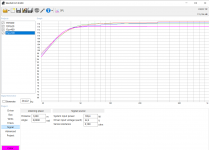
Here them all in 200l box, more extension, again db or two differences between all of them.
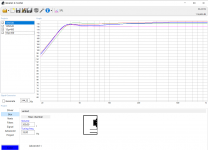
There is more difference with maximum performance, if box size is again 120l the 15pr400 xmax limits the performance. The others work fine, only need more power to get the higher SPL. Only 120W makes the 15pr400 to reach excursion limit so the previous examples wouldn't work out for it.
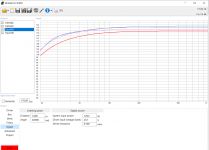
Figure out your SPL target you need to reach with the woofer, and then compare the box size and extension against that with amplifier power you have available. I suspect all of them drivers can satisfy your SPL target if the box size and amplifier power is not limited. In this case the extension could be the limit, and to cure that use more and/or bigger drivers.
It all revolves around the size / SPL / extension trinity 😀
edit, here is 4 of the drivers, all in 120l enclosure with ~fs tuning (what winISD automatically suggested). 200W of power would have all of them play 115db at 40Hz. There are some difference higher up, db or two. Room would introduce +-10db stuff over these nice graphs 😉

Here them all in 200l box, more extension, again db or two differences between all of them.

There is more difference with maximum performance, if box size is again 120l the 15pr400 xmax limits the performance. The others work fine, only need more power to get the higher SPL. Only 120W makes the 15pr400 to reach excursion limit so the previous examples wouldn't work out for it.

Last edited:
^ edit time over. on the last image all fs was set to 35Hz. Here comparison if box was 80l and max power before xmax. All of the drivers get to ~35Hz 115db except the 15pr400.
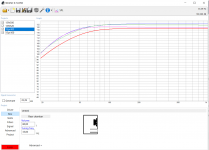
Basically, for home use, there are not that much difference between the various 15" drivers considering the low frequency extension/SPL assuming reaching maximum SPL is not needed. If maximum SPL was required for given sized box then there might be need for more careful consideration. For example the 15pr400 might not suit all cases. Or, if you had particularly small amplifier then you could pick a driver that is suitable compromise between efficiency (max SPL from the amplifier) and extension.
Above drivers perform about the same, but the 15pr400 lags behind on max performance due to less xmax.
Now, if this is for multiway speaker I would much more consider performance at the upper end of the bandwidth. The bass is kind of enough anyway, and if it is not you can always add more bass speakers after the fact, this would also benefit the fact that room effect gets averaged out. Same goes to the speaker construct, concentrate to get the upper end of each way to perform its best since there can always be another way below to fix problems in the low end of bandwidth. In this case you could always add subwoofer(s) to improve bass performance but there is nothing you can do to fix the midrange performance other than considering the whole construct again.

Basically, for home use, there are not that much difference between the various 15" drivers considering the low frequency extension/SPL assuming reaching maximum SPL is not needed. If maximum SPL was required for given sized box then there might be need for more careful consideration. For example the 15pr400 might not suit all cases. Or, if you had particularly small amplifier then you could pick a driver that is suitable compromise between efficiency (max SPL from the amplifier) and extension.
Above drivers perform about the same, but the 15pr400 lags behind on max performance due to less xmax.
Now, if this is for multiway speaker I would much more consider performance at the upper end of the bandwidth. The bass is kind of enough anyway, and if it is not you can always add more bass speakers after the fact, this would also benefit the fact that room effect gets averaged out. Same goes to the speaker construct, concentrate to get the upper end of each way to perform its best since there can always be another way below to fix problems in the low end of bandwidth. In this case you could always add subwoofer(s) to improve bass performance but there is nothing you can do to fix the midrange performance other than considering the whole construct again.
Last edited:
Yes thanks for that interesting point of view...
So the conclusion would be for the 15PR400 which is very smooth event in the mids ?
I read somewhere that it is good to listen to the woofer "raw" to see how it sounds. I guess the 15PR400 would do well like this.
So the conclusion would be for the 15PR400 which is very smooth event in the mids ?
I read somewhere that it is good to listen to the woofer "raw" to see how it sounds. I guess the 15PR400 would do well like this.
For that I don't have opinion other than the thought process here. Never looked more closely into it, comparing drivers. Bought few drivers few years back and those are what I'm playing with 😀 For a 2 way speaker this would be paramount I think, to pick a driver that has best performance both listening and measuring, on the mids. Although many issues can be corrected with EQ people debate about difference in sound. This would depend highly where and how steep the crossover is, if it is higher where the driver starts to beam and have all kinds of resonances then yes definitely some differences. For 3-way speaker I'm not so sure there is that much of a difference even with 2nd order filter. Anyway, I would choose driver based on its performance on the top end of its intended bandwidth.
I guess even the datasheets give enough hint if some driver performs better on the mid range. If there are blips in the impedance plot close to bandwidth you intend to use the driver then yes try to pick one that performs better. Inspect the impedance plot with the frequency response and try to see where and how severe the resonances are. Nice thing about 15pr400 is that it is widely used, seems to be liked, so it is a safe bet, you'll always find buyer if you want to sell them. You could buy another pair you are interested in to compare against, especially if they pop up in the used market. There is hardly any money to lose with second hand drivers, just don't pay premium. Comparing several drivers will teach a lesson or two. For example, there might be difference in motor noise, which can be audible (distortion plot) and be very important for open baffle speakers but perhaps not big of a deal with sealed cabinet.
This is what I've reasoned with the experience I have so, perhaps others have better arguments how to pick a driver over another.
I guess even the datasheets give enough hint if some driver performs better on the mid range. If there are blips in the impedance plot close to bandwidth you intend to use the driver then yes try to pick one that performs better. Inspect the impedance plot with the frequency response and try to see where and how severe the resonances are. Nice thing about 15pr400 is that it is widely used, seems to be liked, so it is a safe bet, you'll always find buyer if you want to sell them. You could buy another pair you are interested in to compare against, especially if they pop up in the used market. There is hardly any money to lose with second hand drivers, just don't pay premium. Comparing several drivers will teach a lesson or two. For example, there might be difference in motor noise, which can be audible (distortion plot) and be very important for open baffle speakers but perhaps not big of a deal with sealed cabinet.
This is what I've reasoned with the experience I have so, perhaps others have better arguments how to pick a driver over another.
Last edited:
What impedence plot, from the datasheets or from the simulation software ?
Troels says that 15PR400 is good because the impedance pick is very well defined...
I think I will end up with not too heavy mms and around 0.3 QTS to take less risk...
I sold my 2226H when I became a father 12 years ago...They "only" cost 440€
https://jblpro.com/en-US/site_elements/2226h-j-specification-sheet
Troels says that 15PR400 is good because the impedance pick is very well defined...
I think I will end up with not too heavy mms and around 0.3 QTS to take less risk...
I sold my 2226H when I became a father 12 years ago...They "only" cost 440€
https://jblpro.com/en-US/site_elements/2226h-j-specification-sheet
- Home
- Loudspeakers
- Multi-Way
- Pro woofers with high-end hifi specs
